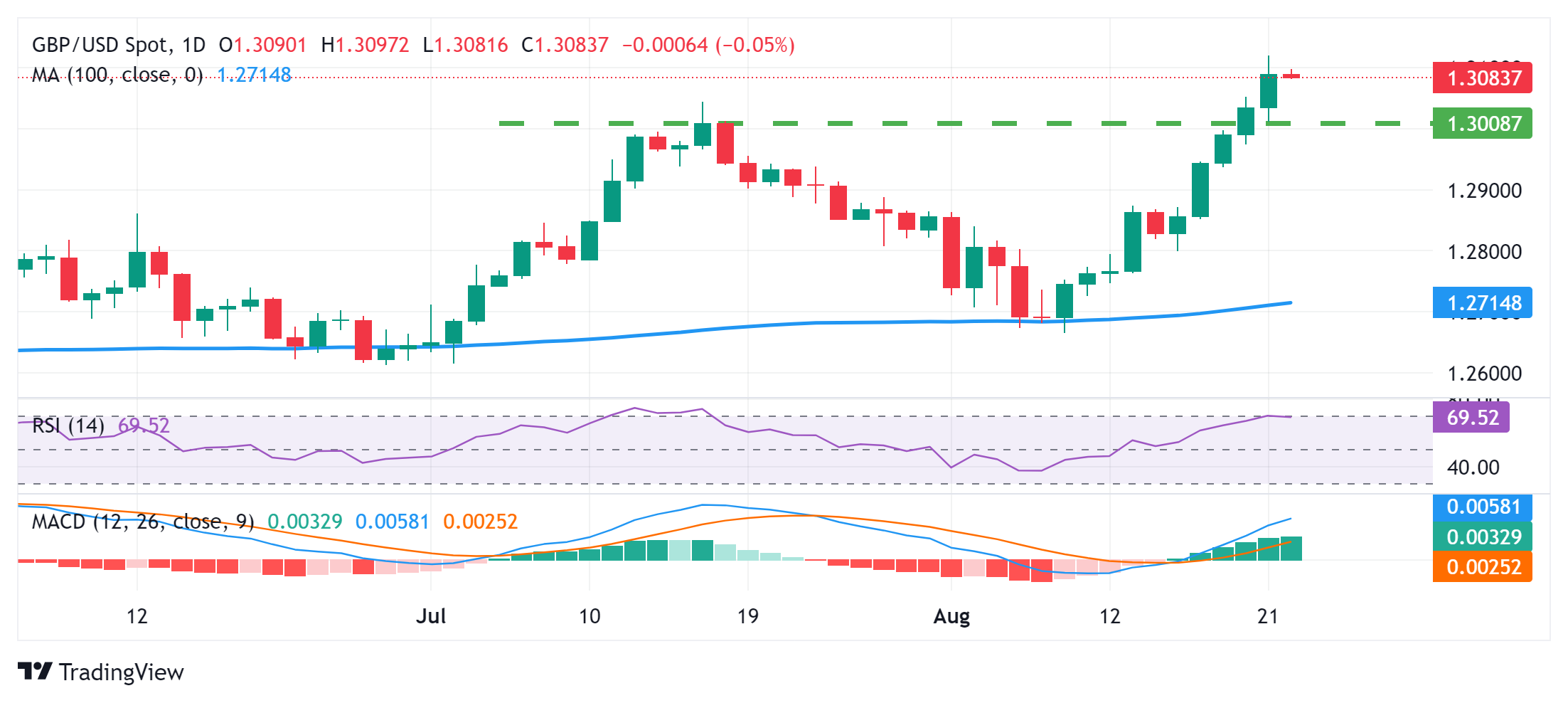GBP/USD Price Prediction: Consolidates below 1.3100 and YTD peak, bullish potential intact


- GBP/USD bulls turn cautious amid the emergence of some USD buying on Thursday.
- The divergent BoE-Fed policy expectations might continue to lend support to the pair.
- The technical setup warrants caution for bulls and before positioning for further gains.
The GBP/USD pair oscillates in a narrow band during the Asian session on Thursday and remains within striking distance of its highest level since July 2023, around the 1.3120 area touched the previous day. Spot prices currently trade around the 1.3085 region, nearly unchanged for the day, as traders now look to the flash PMIs from the UK and the US for short-term opportunities.
In the meantime, a modest uptick in the US Treasury bond yields assists the US Dollar (USD) in recovering a bit from the YTD low touched on Wednesday. This, in turn, is seen as a key factor acting as a headwind for the GBP/USD pair, though diminishing odds for another interest rate cut by the Bank of England (BoE) in September lend some support. Furthermore, increasing bets for a more aggressive policy easing by the Federal Reserve (Fed) should cap gains for the buck and contribute to limiting losses for the currency pair.
From a technical perspective, this week's sustained breakout through the 1.3000 psychological mark and a subsequent move beyond the previous YTD peak, around the 1.3045 region was seen as a fresh trigger for bullish traders. That said, oscillators on the daily chart have moved on the verge of breaking into the overbought zone, making it prudent to wait for some near-term consolidation or a modest pullback before positioning for any further appreciating move.
Nevertheless, the bias remains tilted firmly in favor of bulls.
Hence, any further slide towards the 1.3050-1.3045 region could be seen as a buying opportunity and remain cushioned near the 1.3000 round figure. The latter should act as a key pivotal point, which if broken decisively might prompt some technical selling and drag the GBP/USD pair to the next relevant support near the 1.2950 area en route to the 1.2900 mark. Failure to defend the said support levels might suggest that spot prices have topped out in the near term and pave the way for some meaningful corrective decline.
On the flip side, the 1.3120 area, or the YTD peak touched on Wednesday, could act as an immediate hurdle ahead of the 2023 swing high, near the 1.3140 region. Some follow-through buying will reaffirm the constructive setup and set the stage for an extension of the recent strong uptrend witnessed over the two weeks or so. The GBP/USD pair might then aim to surpass the 1.3200 round figure and test the 1.3225-1.3230 resistance zone.

GBP/USD daily chart
Pound Sterling FAQs
What is the Pound Sterling?
The Pound Sterling (GBP) is the oldest currency in the world (886 AD) and the official currency of the United Kingdom. It is the fourth most traded unit for foreign exchange (FX) in the world, accounting for 12% of all transactions, averaging $630 billion a day, according to 2022 data. Its key trading pairs are GBP/USD, aka ‘Cable’, which accounts for 11% of FX, GBP/JPY, or the ‘Dragon’ as it is known by traders (3%), and EUR/GBP (2%). The Pound Sterling is issued by the Bank of England (BoE).
How do the decisions of the Bank of England impact on the Pound Sterling?
The single most important factor influencing the value of the Pound Sterling is monetary policy decided by the Bank of England. The BoE bases its decisions on whether it has achieved its primary goal of “price stability” – a steady inflation rate of around 2%. Its primary tool for achieving this is the adjustment of interest rates. When inflation is too high, the BoE will try to rein it in by raising interest rates, making it more expensive for people and businesses to access credit. This is generally positive for GBP, as higher interest rates make the UK a more attractive place for global investors to park their money. When inflation falls too low it is a sign economic growth is slowing. In this scenario, the BoE will consider lowering interest rates to cheapen credit so businesses will borrow more to invest in growth-generating projects.
How does economic data influence the value of the Pound?
Data releases gauge the health of the economy and can impact the value of the Pound Sterling. Indicators such as GDP, Manufacturing and Services PMIs, and employment can all influence the direction of the GBP. A strong economy is good for Sterling. Not only does it attract more foreign investment but it may encourage the BoE to put up interest rates, which will directly strengthen GBP. Otherwise, if economic data is weak, the Pound Sterling is likely to fall.
How does the Trade Balance impact the Pound?
Another significant data release for the Pound Sterling is the Trade Balance. This indicator measures the difference between what a country earns from its exports and what it spends on imports over a given period. If a country produces highly sought-after exports, its currency will benefit purely from the extra demand created from foreign buyers seeking to purchase these goods. Therefore, a positive net Trade Balance strengthens a currency and vice versa for a negative balance.





